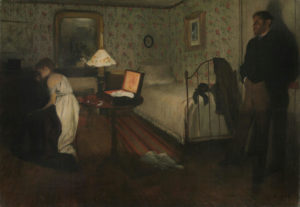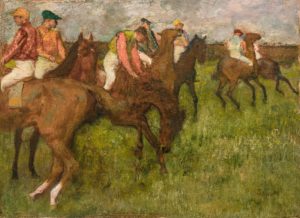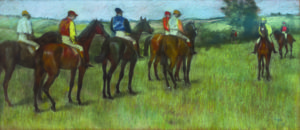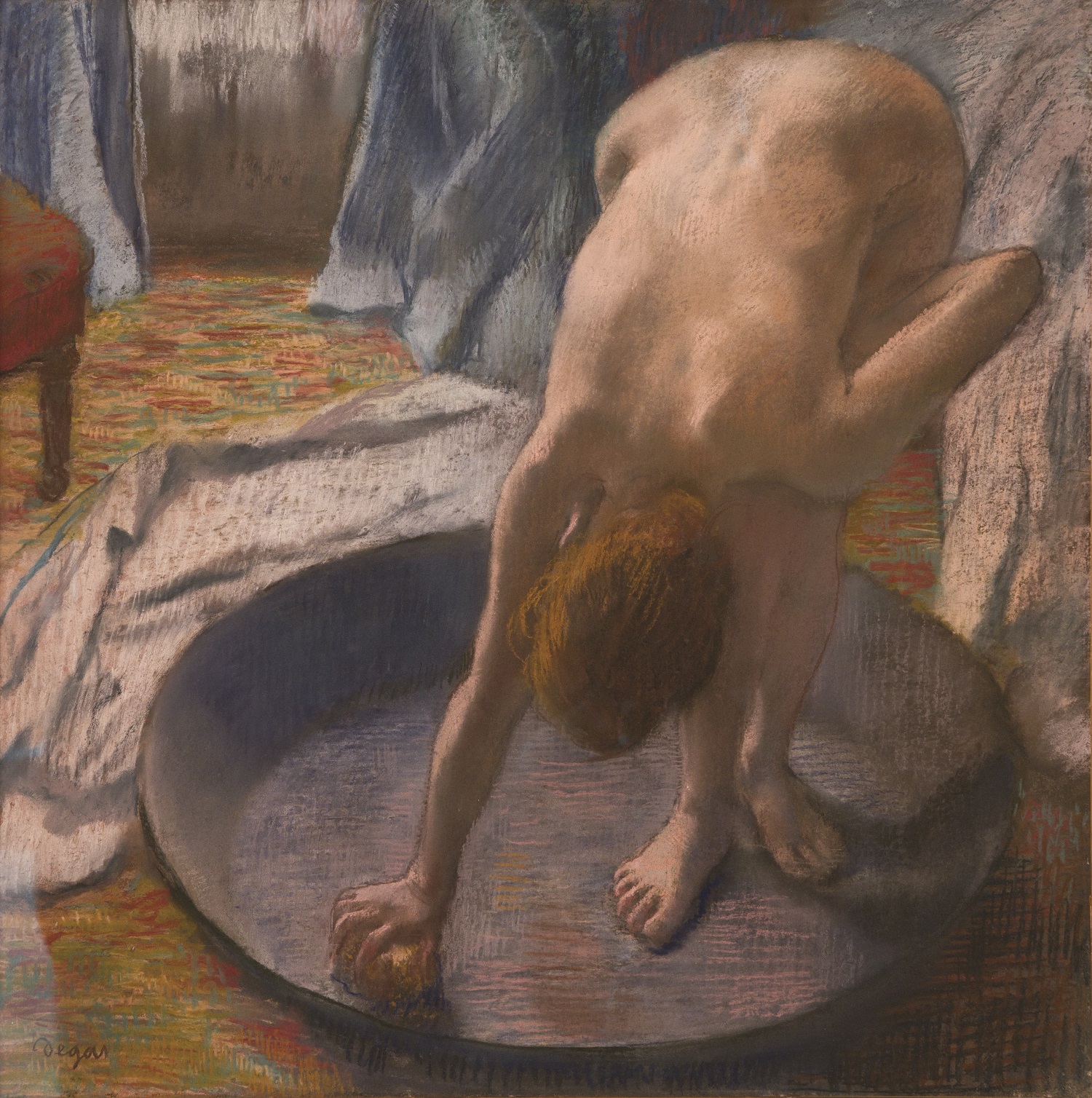Alfred Pope: An Evolution of Ingenuity
Edgar Degas (French, 1834–1917)
6. L’intérieur
7. Jockeys
8. Jockeys
9. Femme au Tub
next
L’intérieur (The Interior), 1868–74

Oil on canvas, 31 7/8 × 45 5/8 in. (81 × 116 cm). Philadelphia Museum of Art, Philadelphia, Pennsylvania.
L’intérieur is one of the most unique works that Alfred owned during his lifetime. The composition, a tense intimate scene between a man and a woman in a bedroom, differs from Degas’s more favored subjects such as ballerinas, jockeys, milliners and infamous characters of Parisian low life, such as various absinthe drinkers. Scholars have suggested the scene illustrates parts of two novels, Thérèse Raquin and L’Assommoir, by Émile Zola (April 2, 1840 – September 29, 1902), a writer and friend of Degas.
Degas sold the painting to Galerie Durand-Ruel, Paris on August 30, 1909. That same day, the work was acquired by author and artist August F. Jaccaci of New York. Jaccaci was a friend of the Popes and a frequent visitor at Hill-Stead. For Christmas 1909, Harris Whittemore, one of Alfred’s closest friends, gifted him L’intérieur. Archival records suggest that Ada Pope, Alfred’s wife, did not enjoy the tense atmosphere depicted in the painting. Though it does not appear in any of the household inventories, it is believed Alfred hung it in his office, a private place where Mrs. Pope would not have to look at it. Upon his death in 1913, the painting was bequeathed to Whittemore. Though for many years the work was on loan at the Metropolitan Museum of Art, it remained in the Whittemore collection until 1936, when it was acquired by Henry P. McIlhenny of Philadelphia. Upon his death in 1986, McIlhenny bequeathed the painting to the Philadelphia Museum of Art.
next
next
Jockeys, c. 1886

Oil on canvas, 10 ¼ × 14 in. (26.1 × 35.8 cm). Ny Carlsberg Glyptotek, Copenhagen.

next
Jockeys, 1886

Pastel on paper, 15 ¼ x 34 ¾ in. (38.5 x 88 cm). Hill-Stead Museum, Farmington, Connecticut.
The oil on canvas version was the first of two jockey scenes that Alfred acquired during his lifetime. He bought it from Durand-Ruel Gallery, New York on December 5, 1892. It was previously in the collections of Hermann Kapferer of Paris and Catholina Lambert of Paterson, New Jersey. The painting remained in the Pope collection until 1936 when Theodate sold it back to Durand-Ruel Gallery. After that, the small but striking painting made its way to Bloomfield Hills, Michigan and Zurich, Switzerland, before entering the collection of the Ny Carlsberg Glyptotek Foundation in Copenhagen, Denmark in 2015.
Alfred acquired the pastel version of Jockeys two years after acquiring the oil painting in 1894 from Galerie Martin & Camentron, Paris. This work usually hangs above the fireplace in the Museum’s dining room.
As seen here, Alfred’s two Jockeys are markedly different, both in terms of medium (oil versus pastel) and composition – the smaller oil piece evokes movement and its fleeting moment in a more compelling fashion. As the artist and art critic Guy Pène du Bois wrote in a 1917 article about Pope’s collection in Arts and Decoration, of the two racehorse pictures “the oil . . . is the more happily composed . . . the more graceful.”
next

next
Femme au tub (The Tub), c. 1885-86

Pastel on blue-grey paper, 27½ x 27½ in. (69.9 x 69.9 cm). Hill-Stead Museum, Farmington, Connecticut.
On August 7, 1907, Alfred acquired this masterpiece from Galerie Durand-Ruel, Paris; it was the last artwork he purchased. Femme au tub had previously been in the collection of the Parisian collector André Pillet. Since acquisition, it has been on view at Hill-Stead. Oftentimes in his work, Degas favored depicting women in intimate, private spaces, such as the bath, the vanity or the backstage of a theater. Out of hundreds of works by this subject matter, Femme au tub is esteemed as one of the finest examples Degas produced.

